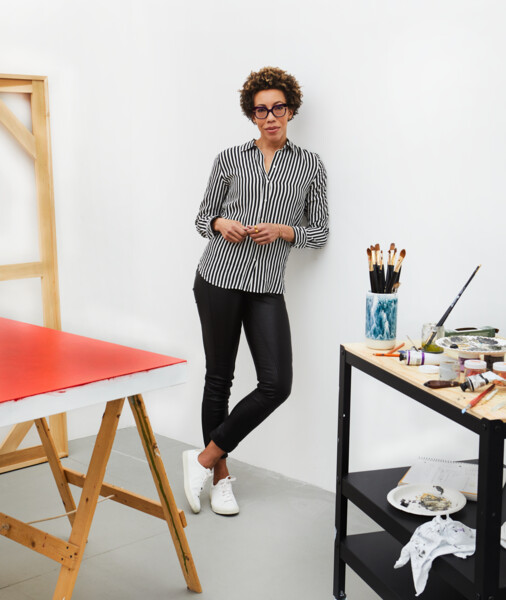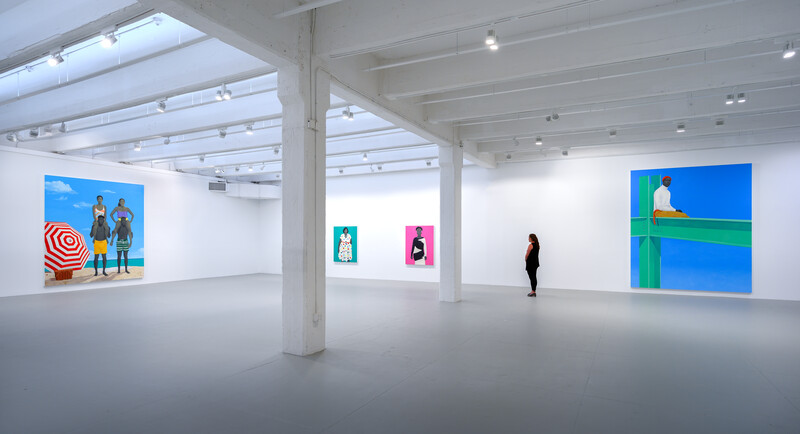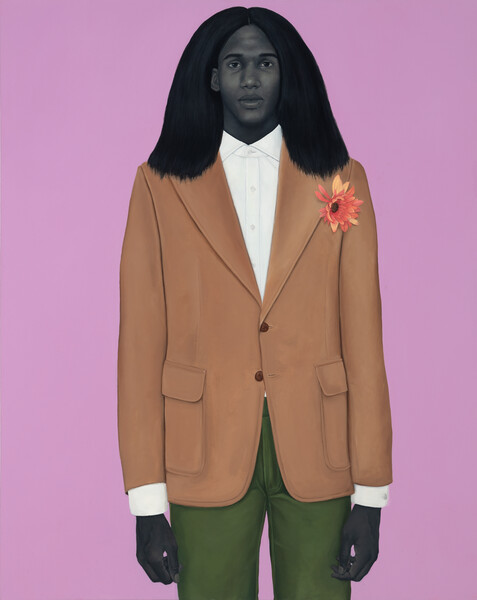Conversations
A conversation between Amy Sherald and Marc Payot

Amy Sherald, Handsome, Oil on canvas, 2019 © Amy Sherald, Courtesy the artist and Hauser & Wirth. Photo: Joseph Hyde
Over the course of a decade, Marc Payot, Partner and Vice President has spearheaded the gallery’s major expansion in the US, which has included taking on a number of significant contemporary American artists. One new addition to the program is Amy Sherald, who speaks with Marc here about what motivates her practice.
Marc Payot: One thing I love about your work is how you have taken the traditional and time-old genre of the portrait and made it feel radical and entirely new. How do you approach portraiture?
Amy Sherald: Portraiture as a genre has come to have a new face. The tradition of portraiture has become a way to reclaim time and space within an art historical narrative that is mostly starkly European. It no longer belongs to the social elite. Artists of color are using portraiture to author a narrative of people that art history was written without. It speaks to the human condition and holds up a mirror to life. It now employs colorful reflections and representations of everyday people on the walls of museums where there were once misrepresentations. Showing life as it is. I like to say it’s the soul food of all the different genres.
MP: Your work starts with a snapshot of someone you find on the street, and the eventual paintings remain photographic in essence. It’s clear you have an interest in photography as a compositional and documentary tool. What does photography mean to you? And how does an interest in photography extend to your work? Do you have an intent?
AS: My first interaction with photography was through my own family photographs. As a very young girl on rainy days, I would sift through boxes and boxes of pictures that my mother kept in our family room cabinet. I was always drawn to a black and white photograph of my Grandmother Jewel whom I never got to meet. She died during childbirth in Alabama after being turned away from a whites-only hospital, not receiving the medical attention she needed. That beautiful black and white photographed portrait of my grandmother was the only means I had of getting to know her. She was wearing a black beret and a houndstooth coat. She looked proud and self-assured. Looking back, it was far different from the representation I had encountered of myself within the art canon.

Amy Sherald in her studio, 2019 Photo: Melanie Dunea

Photo: Sim Canetty-Clarke
MP: So would you say photography for you is about capturing the ‘essence’ of your sitter, about creating a fixed moment to use as a staring point? Can you talk about how you choose your subjects?
AS: Sure. Living in Baltimore, Maryland it was very easy to find the extraordinary living among the ordinary. The people I find seem to possess a kind of presence that feels nostalgic. They are how we saw ourselves in our future, long ago when life was unsure, and freedom came at a cost. There have been a couple of instances where I painted the sitter just as I encountered them, but for the most part they are dressed in clothes that I find in second-hand shops. It’s not always easy to approach people you don’t know and ask them to give something of themselves, something that you can’t explain with words. The joy of finding the right people at the right time is exhilarating. If possible, I always try to shoot the sitter outside in natural light. Normally late morning is the perfect time for me. It usually takes a little bit of time for them to forget about the camera. I have to stand fairly close and this can sometimes be intimidating. I usually get the right shot when we are mid-chat about something other than what we are doing. People often ask if I get to know my models. I say that it’s honestly difficult for me to see them as themselves once the painting commences. They become a symbolic tool shifting our own perceptions of who we are, resurfacing the walls of museums and art history. American art history to be more specific. All that being said the contribution of their presence is inimitable.
‘Artists of color are using portraiture to author a narrative of people that art history was written without. It speaks to the human condition and holds up a mirror to life.’
Once complete I decide my background color based on the outfit, or vice versa. The drawing is done directly on the canvas primarily in charcoal, which offers me the flexibility of erasure while in the process of solidifying the drawing. Once the drawing is complete, that painting begins. The details of the image can sometimes deviate from the original photograph sketch, but for the most part it stays true to the image that I start with.

Installation view, ‘Amy Sherald. the heart of the matter...,’ Hauser & Wirth New York, 22nd Street, 2019

Amy Sherald, When I let go of what I am, I become what I might be (Self-imagined atlas), 2018 © Amy Sherald
MP: So the sitters you find are your ultimate inspiration, and your use of photography clearly has personal roots in your own experience of photography as a ‘memorializing’ tool. How does an interest in photography extend to your work?
AS: Yes, most of my inspiration comes from photography. I have been captivated by its capacity to narrate a truer history that counters a salient dominant historical narrative. It was the first medium I saw that made what was absent, visible. It gave people who once had no control over the proliferation of their own image the ability to become authors of their own narratives. In regard to historical painters, Alice Neel is one of my true inspirations. She was a pioneer among women artists. Although minimally rendered, her paintings feel to me more alive than the most detailed paintings. I also find inspiration among my contemporaries. Women like Njideka Akunyili Crosby and Lynette Yiadom-Boakye are redefining and changing the face of painting and addressing the history of representation.
MP: Your work feels ‘American.’ Where do you see your work in relation to the larger American painting tradition?
AS: I really see myself working within the tradition of American Realism. I look at America’s heart—people, landscapes, and cityscapes—and I see it as an opportunity to add to an American art narrative that was written by painters who were mostly white and male. The stories of American Realism recognize how America found its identity in its art. I paint because I am looking for myself in art history and in the world.
Amy Sherald’s inaugural exhibition with Hauser & Wirth, ‘the heart of the matter…’, opens in New York on 10 September 2019.
